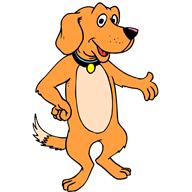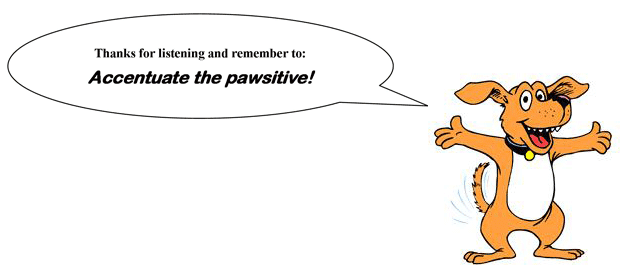The Power Of… Praise!
 Good Dog!
Good Dog!
Two words that we most enjoy saying to our beloved canine companions and so it should be. I’ve been struck by the lack of attention paid to positive reinforcement in the popular dog training programs on television where so much emphasis is placed on obedience, discipline, and being the dominant “alpha” in your dog’s pack; which is ironic considering that for many years “Dominance Theory” in dogs has been proven to be greatly flawed. Dominance theory and its faults is something I’d like to talk about in a future article.
Not unlike our children, dogs need to understand the limits of what they can do and the consequences for exceeding those limits. For many years the popular focus in teaching our dogs was to; “Ignore the negative and only reward the positive behaviour.” Sounds ideal but in reality there are situations when a discipline communication is necessary for our dog to learn. For example: How is our dog to understand that they are not allowed to eat our underwear? By praising them when they are not dining on our undergarments? Clearly, this is not a situation where you can ignore the negative and only reward the positive.
There is a time for No but we must be vigilant in recognizing opportunities to say Yes. The more focus we place on the good they do; the less often we need to tell them… No.
It seems to be human nature that we are attentive to identifying the wrong our dogs do so that we can correct it but in doing so we often miss opportunities to accentuate the good behaviour.
It’s true that there is a balance of learning, in which we need to communicate to our dog how we feel about both the good, and the not so good they do but in my opinion the more important of the two is by far… accentuating the positive.
Praise is a powerful tool in teaching our dogs but like any tool, it can be ineffective if not used properly. I hope the following tips will help you in utilizing praise to its greatest potential.
The mechanics of effective praise (positive reinforcement).
Timing
I would say that the timing of giving your dog praise is the most critical facet of effective teaching. Praise too early and you may be rewarding your dog for doing something other than what you intended. Praise too late and your dog may not learn the lesson at all.
Timing is especially important when your dog is a puppy and just starting to figure out what and how you are teaching. When teaching a “recall”, if you deliver the cue for them to come to you, then as your puppy turns, starts to approach and you deliver an excited; “Good boy!!” as encouragement, there’s a chance that your pup will stop in their tracks and puzzle about what it was they were just doing that deserved your praise.
As your pup turns to approach and perhaps hesitates, it would be better to encourage them by repeating the signal for them to come, in a happy, excited voice and reserve your praise until the exact moment their nose touches your outstretched hand.
When teaching your dog to “sit”, you would wait until the very moment their bum hits the ground before praising. The same would be so when asking your dog to lie down. The dog reclines and gets a “Good dog!” Sometime we get complacent about the stellar behaviour of our canine companion and forget to praise. If it only happens once in a while… no problem but if we don’t praise their good behaviour at least intermittently the strength of the behaviour is going to fade.
I’ve met quite a number of folks who have a dog that will lie down whenever it is asked to sit. This happens because they have asked their dog to sit… then lie down; forgetting to praise their dog for sitting before asking them to lie down. Because the behaviours are not treated separately by the human, the dog; being the smart animal they are, recognize that they are asked to sit and then are rewarded when they lie down. Without positive reinforcement for sitting they will fast track to the identified goal… lying down.
Intermittent Reinforcement
This is an invaluable tool for maintaining the reliability of your dog’s response to your signals. Though you may give your dog a “Good boy/girl” each time they respond as you’ve asked; by using the intermittent reinforcement tool of delivering a treat each 3rd or 4th time they succeed is a great way of increasing the strength of the praise. Your dog will never be certain just when the added bonus is delivered and will respond eagerly each time… just in case. (This works with children as well.) (Don’t tell my daughter I told you this.)
Appropriate Intensity
When we are first teaching our puppies or even when teaching our adult dog something new, it’s important to make the lesson fun and exciting when they succeed. However, once they’ve learned something well, you can vary the intensity of your praise to match the quality of their response. For example; I call my dog to me and he comes but takes his time about it, stops and says hello to a dog or two and them ambles toward me and touches his nose to my hand. He did what was asked although not as well as is usual for him. Still… he did come and touch my hand so I will tell him “good boy” but calmly and casually. On the other hand; if I call for my dog and he breaks away from a group of other dogs, passes by three squirrels, six rabbits and a filled bowl with a sign that reads… Free Dog Treats, and passes by without deviation and rockets his nose toward my outstretched hand; he’s going to get a “GOOD… BOY!!!” a pocketful of treats, a tummy rub and a kiss on the head.
Dogs are indeed smart enough to recognize the difference in our reaction to their “good” behaviour or “awesome!” behaviour. Like anything else they learn from us, it takes a few times for them to recognize the pattern in our behaviour but they will learn… the better their response… the greater the rewards.
As well, there is such a thing as praising too much and too often. If our dogs get excited praise and a treat for every little thing they do, in time they will become desensitized to praise and the value of their reward would weaken and become less effective.
Make your rewards fit the quality of their behaviour and moderate the amount of times you praise and the rewards you give will mean so much more to your dog.
When Not To Praise
Sometimes we inappropriately praise our dog without really realizing it. For example: Rover is growling at somebody and you; feeling a bit embarrassed, lean down and ruffle their fur and say; “Oh for goodness sake Rover, stop being such a Mr. Cranky Pants.” Rover has just displayed an aggressive warning and your response was to pet him and talk to him pleasantly; essentially rewarding the aggressive behaviour. This is a circumstance that calls for discipline and redirection not praise.
In my mind the most important time to resist praising inappropriately is immediately after a discipline communication. Just about every dog trainer I’ve met teaches their clients to tell their dog No for doing something they shouldn’t and if the dog stops, praise the dog for being a good listener.
Firstly, this never happens among dogs. If Fido is getting too close to Rover’s favourite toy, Rover will become still, make eye contact with Fido, curl his flews and perhaps growl. Fido, taking the hint, will stop advancing and move away. When Fido has backed away to Rover’s satisfaction Rover will simply return to playing with his toy. At no time is there any indication that Rover turns to Fido and praises him in gratitude for being a good listener.
Behaviour is shaped by its final and strongest consequence. When you ask your dog to “Sit” and they do, the consequence to them is “Good dog!” and perhaps a treat. The consequence (Good dog! & treat) shapes their behaviour (they sit).
When a discipline communication is immediately followed by a rewarding communication it is a mixed message which weakens or negates the discipline.
Your dog misbehaves and is told No! She stops what she’s doing, looks up at you then immediately hears… Good girl! Your intent is to reward her for stopping but at the least you are sending her a mixed message. Unfortunately, we are often so tickled that our dog listened and stopped what it was doing, that we heap on the praise because we want our dog to be aware how happy we are that they listened. From Rover’s perspective she is hearing a “No…bad dog.” from you and stops to figure out what you are talking about then immediately hears… “Good girl! What a good girl you are!”
Rover will be pondering; “Geez you were so cranky for a moment there but just a few seconds after were really happy and complimentary. What was I just doing? Oh right! I was just about to eat that underwear! Well… he seems to be quite happy with me so I’ll carry on.”
It’s tough to tell your dog to stop doing something and not reward them for listening to you. It feels counter intuitive but it’s the doggy way. Reserve praise for those times when your dog makes good decisions without being told No.
Many anxious and fearful dogs that I have worked with have become confident and trusting because their owners stopped delivering angry, agitated discipline followed by praise for good listening and instead learned to deliver calm discipline and dispensed with praise for good listening. With calm assertion and no mixed messages that are confusing, their dogs better understand what is being communicated and quickly gain confidence allowing their anxieties to melt away.
© 2011 Steve J. Huxter All Rights Reserved



